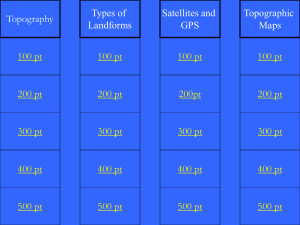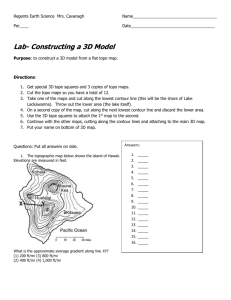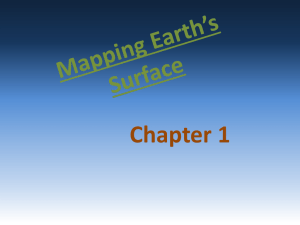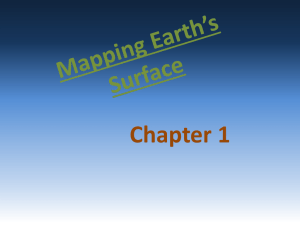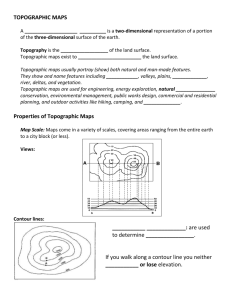Building Topographic Model
advertisement
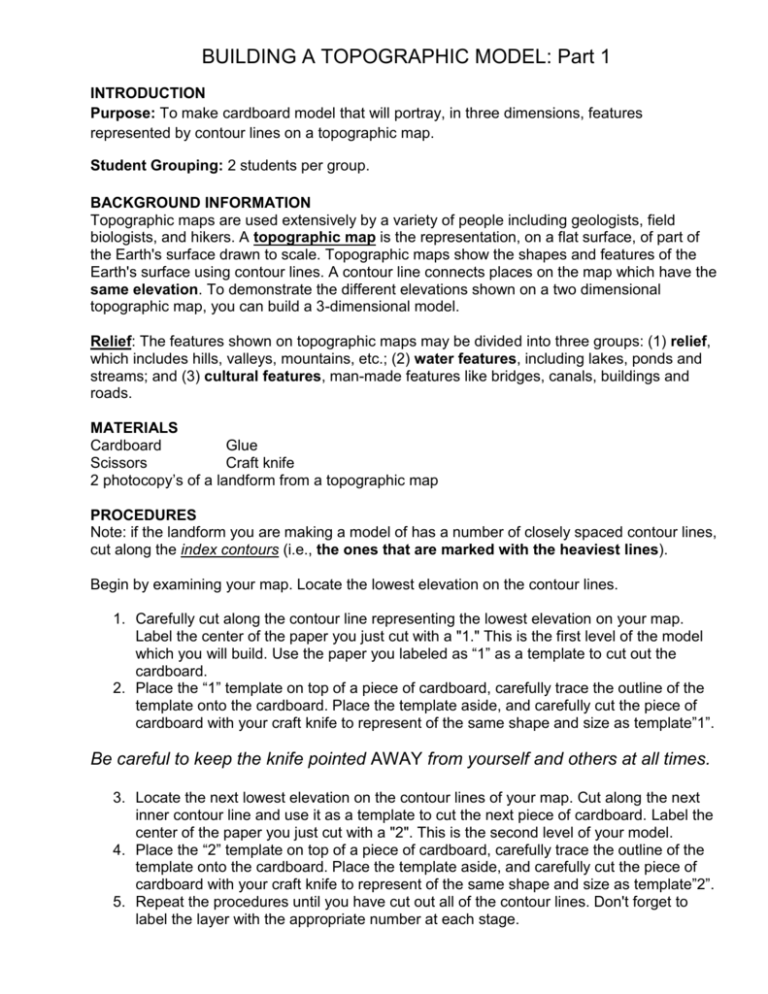
BUILDING A TOPOGRAPHIC MODEL: Part 1 INTRODUCTION Purpose: To make cardboard model that will portray, in three dimensions, features represented by contour lines on a topographic map. Student Grouping: 2 students per group. BACKGROUND INFORMATION Topographic maps are used extensively by a variety of people including geologists, field biologists, and hikers. A topographic map is the representation, on a flat surface, of part of the Earth's surface drawn to scale. Topographic maps show the shapes and features of the Earth's surface using contour lines. A contour line connects places on the map which have the same elevation. To demonstrate the different elevations shown on a two dimensional topographic map, you can build a 3-dimensional model. Relief: The features shown on topographic maps may be divided into three groups: (1) relief, which includes hills, valleys, mountains, etc.; (2) water features, including lakes, ponds and streams; and (3) cultural features, man-made features like bridges, canals, buildings and roads. MATERIALS Cardboard Glue Scissors Craft knife 2 photocopy’s of a landform from a topographic map PROCEDURES Note: if the landform you are making a model of has a number of closely spaced contour lines, cut along the index contours (i.e., the ones that are marked with the heaviest lines). Begin by examining your map. Locate the lowest elevation on the contour lines. 1. Carefully cut along the contour line representing the lowest elevation on your map. Label the center of the paper you just cut with a "1." This is the first level of the model which you will build. Use the paper you labeled as “1” as a template to cut out the cardboard. 2. Place the “1” template on top of a piece of cardboard, carefully trace the outline of the template onto the cardboard. Place the template aside, and carefully cut the piece of cardboard with your craft knife to represent of the same shape and size as template”1”. Be careful to keep the knife pointed AWAY from yourself and others at all times. 3. Locate the next lowest elevation on the contour lines of your map. Cut along the next inner contour line and use it as a template to cut the next piece of cardboard. Label the center of the paper you just cut with a "2". This is the second level of your model. 4. Place the “2” template on top of a piece of cardboard, carefully trace the outline of the template onto the cardboard. Place the template aside, and carefully cut the piece of cardboard with your craft knife to represent of the same shape and size as template”2”. 5. Repeat the procedures until you have cut out all of the contour lines. Don't forget to label the layer with the appropriate number at each stage. 6. Now you are ready to build your 3-D model. Begin by stacking the cut pieces of cardboard one atop the other to ensure they are correctly placed in order. 7. Glue the stacked layers together until you have built your model. 8. Compare the model to an uncut version of your map. Topographic Cross-sections: Part 2 – use uncut version of your map When looking at a topographic map, you are seeing the landscape from directly above (often referred to as “map view”). Sometimes it is useful to visualize how the landscape would look in profile. Constructing a topographic cross-section gives us a side view of the landscape along a line. You can think of a cross-section as the topography you would encounter as you walked a straight line between two points. A profile is unexaggerated if the horizontal and vertical scales are the same. To emphasize the differences in relief in a comparatively flat area, the vertical scale may be expanded relative to the horizontal scale, producing a crosssection with vertical exaggeration. Vertical exaggeration is given by: E=H/V where E = vertical exaggeration H = denominator of the horizontal scale fraction V = denominator of the vertical scale fraction One efficient way to construct topographic cross-sections is outlined below: 1. Lay a strip of blank paper along the line you want to profile. In your case A to A’. 2. Mark on the edge of the paper endpoints of the profile line and the exact place that each contour, stream, and hilltop crosses the profile line. Where contour lines are closely spaced, it is sufficient to label just the index contours (every fifth contour, drawn bold on topographic maps). Double-check yourself every five lines or so. 3. Label each mark with the contour elevation or other feature it represents. 4. Determine the total relief of the profile line. Relief is the difference in elevation between the highest and lowest points. * First determine the elevation of each location. To find the elevation of a point, locate the index contour nearest the point, and then count contour lines up or down to the point. Next, subtract one elevation from the other, and the difference is the vertical difference (rise). Estimating slope is a simple mathematical process. The formula is: VD or RISE = Vertical Distance (difference in elevation between two points; subtract one point in elevation from the other point). HD or RUN = Horizontal Distance measured with ruler on a map, from one point to the other). 5. Prepare a vertical scale on a sheet of graph paper or lined paper based on the relief. Label the horizontal lines on this sheet to correspond to the elevation of each index contour line 6. Write down the vertical exaggeration of your profile. Compare what an inch represents on each of your axes using the equation given above. Be sure to exaggerate only when needed for clarity. 7. Place the plain paper with labeled marks at the bottom (or top) of the profile paper and carefully project each contour onto the horizontal line of the same elevation. 8. Connect all of the points with a smooth line. Mark streams, peaks, benchmarks (points of exact elevation, as surveyed), etc. 9. Check that your profile matches the general topography along your transect line. Drawing a cross-sectional profile. Notice the tick marks along some contours indicating a depression.


